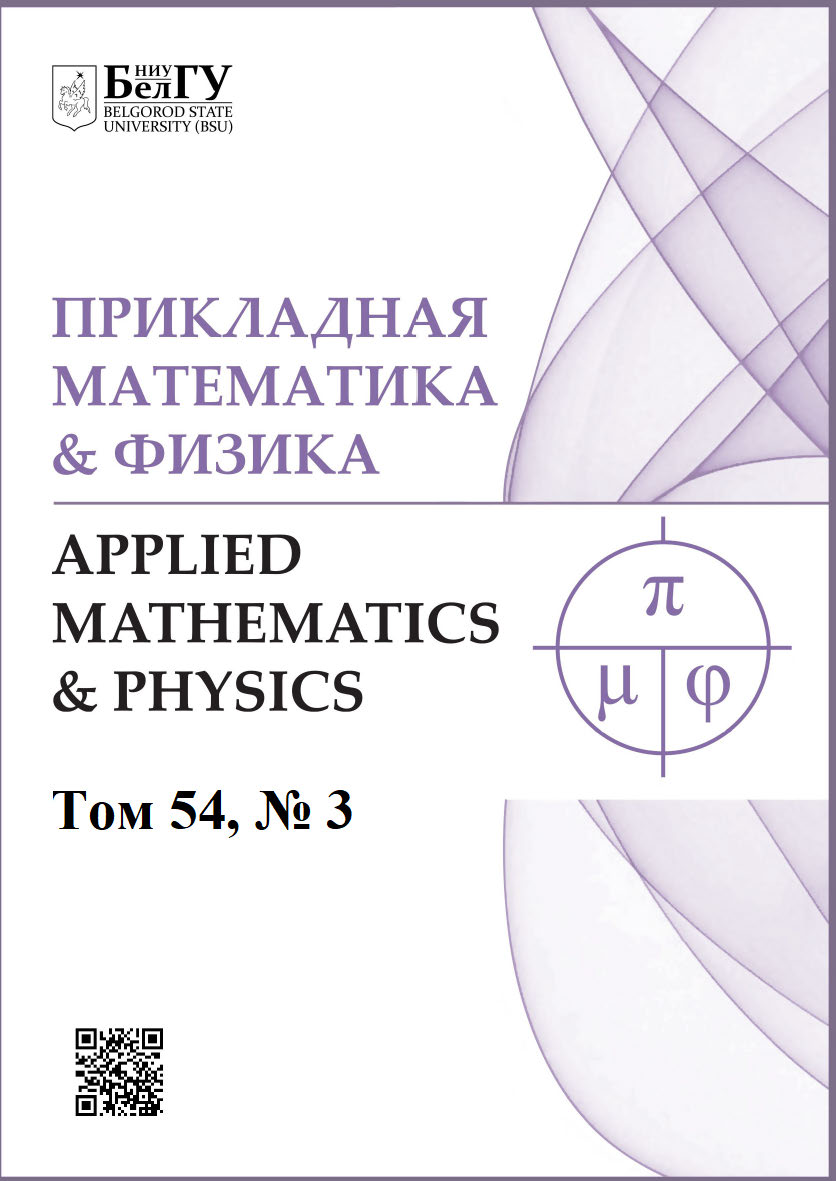Solution of the nonlinear ordinary differential equation of Ermakov by power series
DOI:
https://doi.org/10.52575/2687-0959-2022-54-3-171-177Keywords:
mathematical modeling, symbolic-numerical methods, software packages, differential equation, nonlinear ordinary differential equation of second order, equation of Ermakov, power seriesAbstract
Nonlinear differential equations are widely used in various modern sciences. In particular, the nonlinear ordinary differential equation of Ermakov is successfully used to solve problems in quantum mechanics, electrodynamics, optics, elasticity theory, to describe molecular structures, in heterostructures with a complex potential function and in many other branches of theoretical and mathematical physics. However, there is currently no effective method for solving nonlinear equations such as the Ermakov equation. For example, when solving eigenvalue problems, known modern authors calculated solutions of the Ermakov equation by direct numerical methods. As is known from the works of Ermakov himself and other modern authors, the solution of the Ermakov equation is determined by two linearly independent solutions of a suitable so-called attached linear differential equation of the second order. The theory of integration of linear differential equations by power series is mathematically strictly developed, in particular, for the attached linear equations to the Ermakov equation, the convergence of power series representing the solution of the attached linear differential equations is proved. In this paper, these linearly independent solutions of the attached linear equation were calculated in the form of power series using the MAPLE analytical computing computer system and for a number of Ermakov equations, their solutions were constructed in the form of power series, in general, with an arbitrary number terms. By direct substitution, it was shown that the power series obtained in this way satisfy the Ermakov equation. The obtained solutions in the form of power series containing also a spectral parameter can be successfully applied to solving eigenvalue problems, in particular for solving the stationary Schrodinger equation.
Downloads
References
đĹđÁđ╗đÁĐćđ║đŞđ╣ đĺ. đĺ., đáđżđĚđżđ▓ đŁ. đą. 2005. đÜ 70-đ╗đÁĐéđŞĐÄ đŤ. đť. đĹđÁĐÇđ║đżđ▓đŞĐçđ░. đĺđÁĐüĐéđŻđŞđ║ đíđ░đ╝đôđú, đĽĐüĐéđÁĐüĐéđ▓đÁđŻđŻđżđŻđ░ĐâĐçđŻđ░ĐĆ ĐüđÁĐÇđŞĐĆ, 6(40): 5ÔÇô14.
đĹđÁđ╗ĐĆđÁđ▓đ░ đś. đŁ., đúđ║đżđ╗đżđ▓ đ«. đÉ., đžđÁđ║đ░đŻđżđ▓ đŁ. đÉ. 2005. đčđżĐüĐéĐÇđżđÁđŻđŞđÁ đżđ▒ĐëđÁđ│đż ĐÇđÁĐłđÁđŻđŞĐĆ đ┤đŞĐäĐäđÁĐÇđÁđŻĐćđŞđ░đ╗ĐîđŻĐőĐů ĐâĐÇđ░đ▓đŻđÁđŻđŞđ╣ ĐäĐâđ║Đüđżđ▓Đüđ║đżđ│đż ĐéđŞđ┐đ░ đ▓ đ▓đŞđ┤đÁ ĐüĐéđÁđ┐đÁđŻđŻĐőĐů ĐÇĐĆđ┤đżđ▓. đíđ▓đŞđ┤đÁĐéđÁđ╗ĐîĐüĐéđ▓đż đżđ▒ đżĐéĐÇđ░Đüđ╗đÁđ▓đżđ╣ ĐÇđÁđ│đŞĐüĐéĐÇđ░ĐćđŞđŞ ĐÇđ░đĚĐÇđ░đ▒đżĐéđ║đŞ đ▓ đ×ĐéĐÇđ░Đüđ╗đÁđ▓đżđ╝ ĐäđżđŻđ┤đÁ đ░đ╗đ│đżĐÇđŞĐéđ╝đżđ▓ đŞ đ┐ĐÇđżđ│ĐÇđ░đ╝đ╝. đť.: đĺđŁđóđśđŽ, Ôäľ50200500089.
đĹđÁđ╗ĐĆđÁđ▓đ░ đś. đŁ., đĹđżđ│đ░ĐçđÁđ▓ đĺ. đĽ., đžđÁđ║đ░đŻđżđ▓ đŁ. đÉ. 2012. đÉđ╗đ│đżĐÇđŞĐéđ╝ ĐüđŞđ╝đ▓đżđ╗ĐîđŻđż-ĐçđŞĐüđ╗đÁđŻđŻđżđ│đż đ▓ĐőĐçđŞĐüđ╗đÁđŻđŞĐĆ ĐäĐâđŻđ║ĐćđŞđŞ đôĐÇđŞđŻđ░ đ┤đŞĐäĐäđÁĐÇđÁđŻĐćđŞđ░đ╗ĐîđŻĐőĐů ĐâĐÇđ░đ▓đŻđÁđŻđŞđ╣ đ▓ĐéđżĐÇđżđ│đż đ┐đżĐÇĐĆđ┤đ║đ░. đĺđÁĐüĐéđŻđŞđ║ đáđúđöđŁ, đíđÁĐÇđŞĐĆ đťđ░ĐéđÁđ╝đ░ĐéđŞđ║đ░, đśđŻĐäđżĐÇđ╝đ░ĐéđŞđ║đ░, đĄđŞđĚđŞđ║đ░, 3: 43ÔÇô51.
đĹđÁđ╗ĐĆđÁđ▓đ░ đś. đŁ., đĹđżđ│đ░ĐçđÁđ▓ đĺ. đĽ., đžđÁđ║đ░đŻđżđ▓ đŁ. đÉ. 2012. đíđŞđ╝đ▓đżđ╗ĐîđŻđż-ĐçđŞĐüđ╗đÁđŻđŻđżđÁ đ▓ĐőĐçđŞĐüđ╗đÁđŻđŞđÁ ĐäĐâđŻđ║ĐćđŞđŞ đôĐÇđŞđŻđ░ đżđ▒Đőđ║đŻđżđ▓đÁđŻđŻĐőĐů đ┤đŞĐäĐäđÁĐÇđÁđŻĐćđŞđ░đ╗ĐîđŻĐőĐů ĐâĐÇđ░đ▓đŻđÁđŻđŞđ╣ đ▓ĐéđżĐÇđżđ│đż đŞ ĐéĐÇđÁĐéĐîđÁđ│đż đ┐đżĐÇĐĆđ┤đ║đżđ▓. đĺđÁĐüĐéđŻđŞđ║ đąđÁĐÇĐüđżđŻĐüđ║đżđ│đż đŻđ░ĐćđŞđżđŻđ░đ╗ĐîđŻđżđ│đż ĐéđÁĐůđŻđŞĐçđÁĐüđ║đżđ│đż ĐâđŻđŞđ▓đÁĐÇĐüđŞĐéđÁĐéđ░, 2(45): 50ÔÇô55.
đĹđÁđ╗ĐĆđÁđ▓đ░ đś. đŁ., đžđÁđ║đ░đŻđżđ▓ đŁ. đÉ., đÜđŞĐÇđŞĐçđÁđŻđ║đż đś. đÉ., đžđÁđ║đ░đŻđżđ▓đ░ đŁ. đŁ. 2019. đíđŞđ╝đ▓đżđ╗ĐîđŻđż-ĐçđŞĐüđ╗đÁđŻđŻĐőđÁ đ╝đÁĐéđżđ┤Đő ĐÇđÁĐłđÁđŻđŞĐĆ đ┤đŞĐäĐäđÁĐÇđÁđŻĐćđŞđ░đ╗ĐîđŻĐőĐů ĐâĐÇđ░đ▓đŻđÁđŻđŞđ╣ đ║đ╗đ░ĐüĐüđŞĐçđÁĐüđ║đżđ╣ đŞ đ║đ▓đ░đŻĐéđżđ▓đżđ╣ đ╝đÁĐůđ░đŻđŞđ║đŞ. đąđ░ĐÇđ║iđ▓: ÔÇťICMAÔÇŁ, 420.
đĹđÁĐÇđ║đżđ▓đŞĐç đŤ. đť., đáđżđĚđżđ▓ đŁ. đą. 1972. đŁđÁđ║đżĐéđżĐÇĐőđÁ đĚđ░đ╝đÁĐçđ░đŻđŞĐĆ đż đ┤đŞĐäĐäđÁĐÇđÁđŻĐćđŞđ░đ╗ĐîđŻĐőĐů ĐâĐÇđ░đ▓đŻđÁđŻđŞĐĆĐů đ▓đŞđ┤đ░ yÔÇ▓ÔÇ▓ + a(x)y = f (x)yÔłĺa . đöđŞĐäĐäđÁĐÇđÁđŻĐćđŞđ░đ╗ĐîđŻĐőđÁ ĐâĐÇđ░đ▓đŻđÁđŻđŞĐĆ, 8(11): 2076ÔÇô2079.
đŚđ░đ╣ĐćđÁđ▓ đĺ. đĄ., đčđżđ╗ĐĆđŻđŞđŻ đÉ. đö. 1997. đíđ┐ĐÇđ░đ▓đżĐçđŻđŞđ║ đ┐đż đ╗đŞđŻđÁđ╣đŻĐőđ╝ đżđ▒Đőđ║đŻđżđ▓đÁđŻđŻĐőđ╝ đ┤đŞĐäĐäđÁĐÇđÁđŻĐćđŞđ░đ╗ĐîđŻĐőđ╝ ĐâĐÇđ░đ▓đŻđÁđŻđŞĐĆđ╝. đť.: đśđĚđ┤-đ▓đż .đĄđ░đ║ĐéđżĐÇđŞđ░đ╗., 304.
đĽĐÇđ╝đ░đ║đżđ▓ đĺ. đč. 1880. đöđŞĐäĐäđÁĐÇđÁđŻĐćđŞđ░đ╗ĐîđŻĐőđÁ ĐâĐÇđ░đ▓đŻđÁđŻđŞĐĆ đ▓ĐéđżĐÇđżđ│đż đ┐đżĐÇĐĆđ┤đ║đ░. đúĐüđ╗đżđ▓đŞĐĆ đŞđŻĐéđÁđ│ĐÇđŞĐÇĐâđÁđ╝đżĐüĐéđŞ đ▓ đ║đżđŻđÁĐçđŻđżđ╝ đ▓đŞđ┤đÁ. đÜđŞđÁđ▓, đúđŻđŞđ▓đÁĐÇ. đśđĚđ▓., 9: 1ÔÇô25.
đťđ░Đéđ▓đÁđÁđ▓ đŁ. đť. 1963. đťđÁĐéđżđ┤Đő đŞđŻĐéđÁđ│ĐÇđŞĐÇđżđ▓đ░đŻđŞĐĆ đżđ▒Đőđ║đŻđżđ▓đÁđŻđŻĐőĐů đ┤đŞĐäĐäđÁĐÇđÁđŻĐćđŞđ░đ╗ĐîđŻĐőĐů ĐâĐÇđ░đ▓đŻđÁđŻđŞđ╣. đť.: đĺĐőĐüĐłđ░ĐĆ Đłđ║đżđ╗đ░, 546.
đíđżđ╗đżđ▓ĐîđÁđ▓ đĽ. đÉ. 1984. đúĐÇđ░đ▓đŻđÁđŻđŞđÁ đťđŞđ╗đŻđ░ đŞ đ▓ĐőĐüĐłđŞđÁ đ┐đżĐÇĐĆđ┤đ║đŞ đĺđÜđĹ đ┐ĐÇđŞđ▒đ╗đŞđÂđÁđŻđŞĐĆ. đčđŞĐüĐîđ╝đ░ đ▓ đľđşđóđĄ, 39(2): 84ÔÇô86.
đóĐÇđŞđ║đżđ╝đŞ đĄ. 1962. đöđŞĐäĐäđÁĐÇđÁđŻĐćđŞđ░đ╗ĐîđŻĐőđÁ ĐâĐÇđ░đ▓đŻđÁđŻđŞĐĆ. đť.: đśđĚđ┤-đ▓đż đŞđŻđżĐüĐéĐÇđ░đŻđŻđżđ╣ đ╗đŞĐéđÁĐÇđ░ĐéĐâĐÇĐő, 352.
đžđÁđ║đ░đŻđżđ▓đ░ đŁ. đŁ., đžđÁđ║đ░đŻđżđ▓ đŁ. đÉ. 2013. đśđŻđ▓đ░ĐÇđŞđ░đŻĐéĐő đżđ┤đŻđżđ╝đÁĐÇđŻđżđ│đż đ│đ░ĐÇđ╝đżđŻđŞĐçđÁĐüđ║đżđ│đż đżĐüĐćđŞđ╗đ╗ĐĆĐéđżĐÇđ░ Đü đĚđ░đ▓đŞĐüĐĆĐëđÁđ╣ đżĐé đ▓ĐÇđÁđ╝đÁđŻđŞ Đçđ░ĐüĐéđżĐéđżđ╣. đĺđÁĐüĐéđŻđŞđ║ đąđŁđóđú, 2(47): 372ÔÇô374.
Athorne C. 1990. Geometry of Ermakov systems. Nonlinear Evolution Equations and Dynamical systems (NEEDSÔÇÖ90), Proc. of the 6th International Workshop, 16-26 July, USSR.: 100ÔÇô103.
Belyaeva I., Kirichenko I., Ptashny O., Chekanova N., Yarkho T. 2021. Integrating linear ordinary fourthorder differential equations in the MAPLE programming environment. Eastern-European Journal of Enterprise Technologies, 3/4(111 ): 51ÔÇô57.
Hansen R. M., Lidsey J. E. 2002. Ermakov-Pinney equation in scalar field cosmologies. Phys. Rev. D, 66. 023523.
Korsch H. J., Laurent H. 1981. MilneÔÇÖs differential equation and numerical solutions of the Shrodinger equation I. Bound-state energies for single- and double-minimum potentials. J. Phys. B.: At. Mol. Phys., 14: 4213ÔÇô4230.
Korsch H. J., Laurent H., Mohlenkamp R. 1982. MilneÔÇÖs differential equation and numerical solutions of the Schrodinger equation II. Complex energy resonance states. J. Phys. B: At. Mol. Phys., 15: 1ÔÇô14.
Lewis H. R. 1968. Motion of a time-dependent harmonic oscillator, and of a charged particle in a class of time-dependent, axially symmetric electromagnetic fields. Phys. Rev., 172(5): 1313ÔÇô1315.
Milne W. 1930.The numerical determination of characteristic numbers. Phys. Rev., 35: 863ÔÇô867.
Pinney E. 1950. The nonlinear differential equation. Proc. Amer. Math. Soc.: 581.
Schuch D. 2008. Riccati and Ermakov equations in Time-Dtpendent and Time-Independent Quantum Sestems. SIGMA 4, 043: 16.
Abstract views: 483
##submission.share##
Published
How to Cite
Issue
Section
Copyright (c) 2022 Applied Mathematics & Physics

This work is licensed under a Creative Commons Attribution 4.0 International License.





